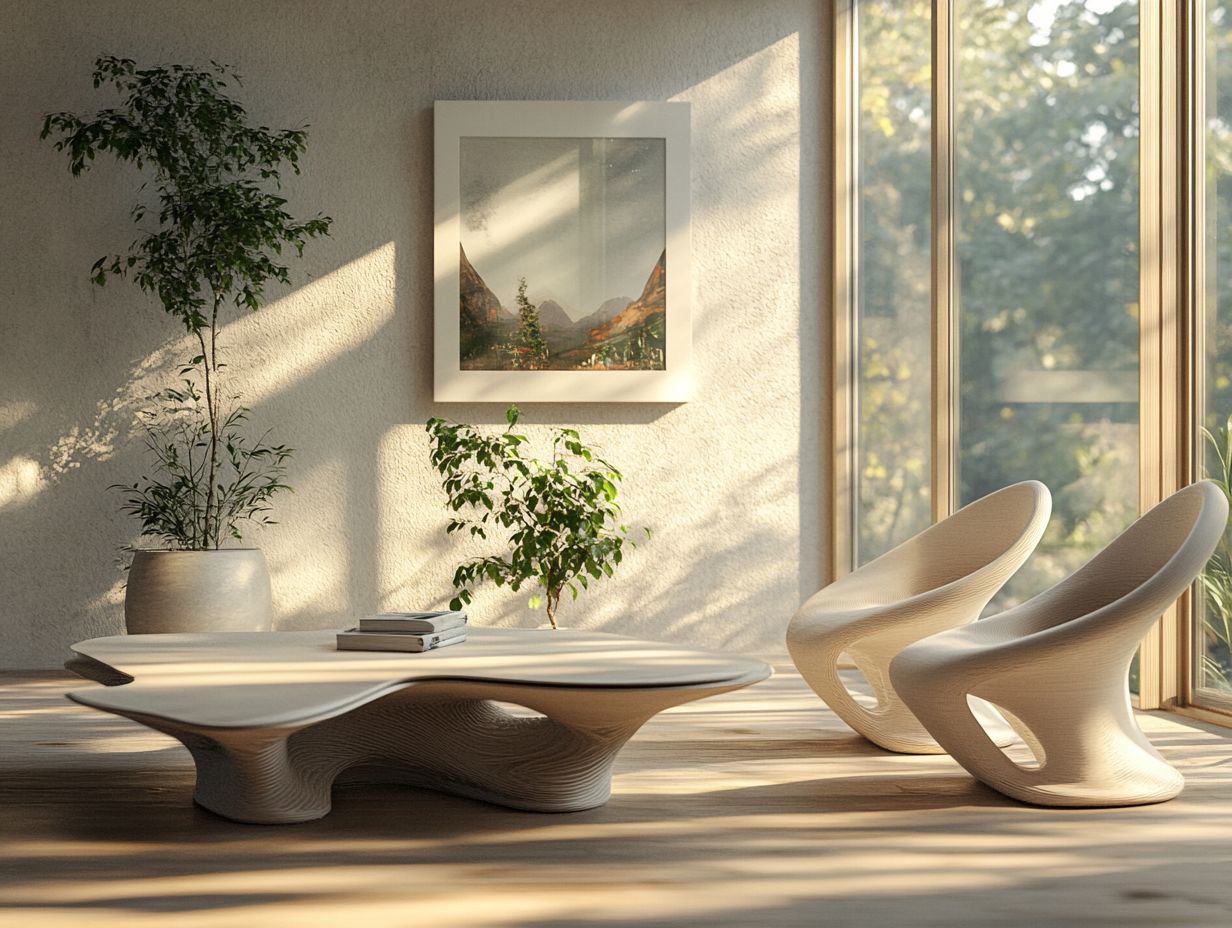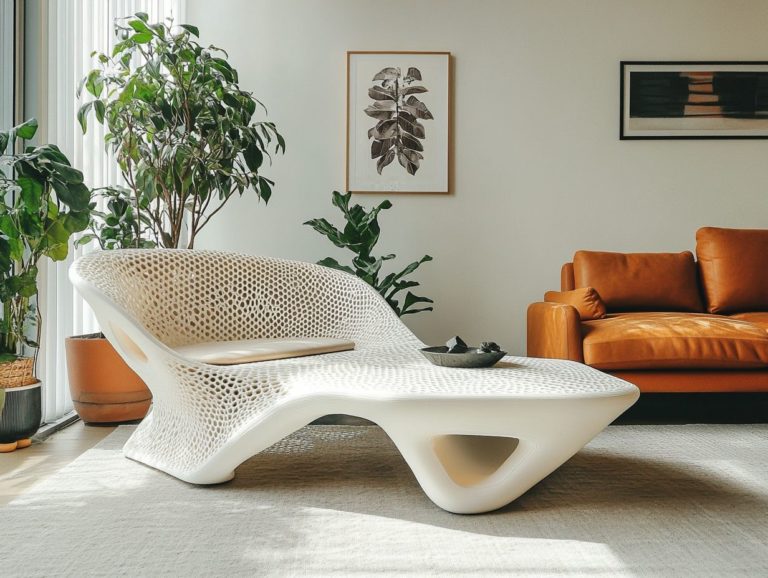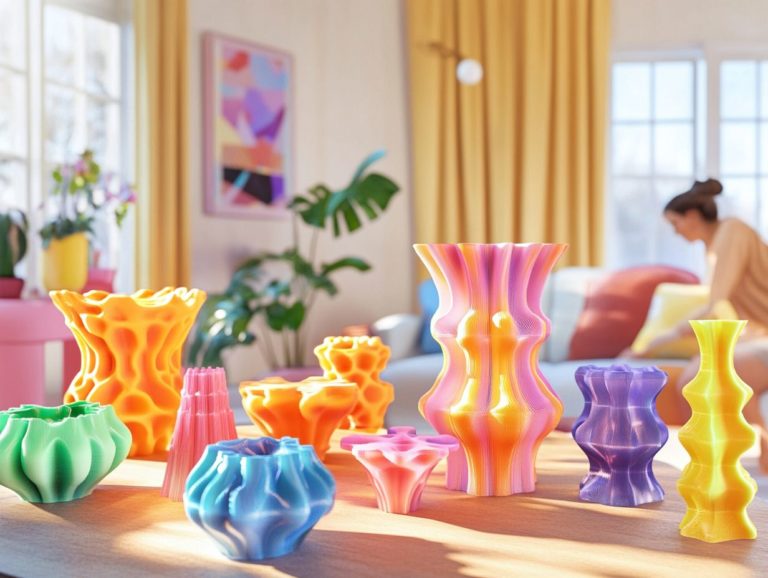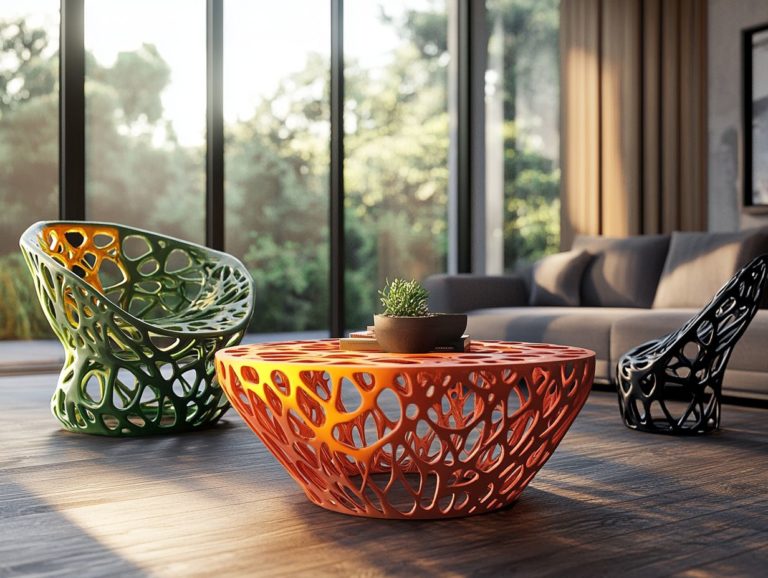How to Style Your Space with 3D-Printed Furniture
3D printing is transforming the landscape of furniture design, presenting innovative solutions that are customizable and eco-friendly.
Explore the benefits of 3D-printed furniture, including cost savings and the use of sustainable materials. Find tips on integrating these unique pieces into your home, draw inspiration from DIY projects, and glimpse the exciting future this technology offers.
Join us now to discover the power of 3D printing in furniture design!
Contents
Key Takeaways:

- Save money and add a personal touch with customizable 3D-printed furniture.
- Reduce your environmental footprint by choosing sustainable, eco-friendly 3D-printed furniture options.
- Embrace creativity by incorporating DIY 3D-printed furniture projects into your space.
What is 3D Printing and How it Works?
3D printing is a revolutionary technology that lets you create three-dimensional objects from digital files. It uses a process that creates objects layer by layer.
Initially developed by pioneers like Hideo Kodama, Charles Hull, and Carl Deckard, this method has advanced significantly, incorporating advanced manufacturing techniques and user-friendly design software.
Now, it enables rapid prototyping in various industries, including home decor and furniture design.
Benefits of 3D-Printed Furniture
The advantages of 3D-printed furniture are extensive, offering cost-effective solutions and the chance to create unique designs that reflect your style.
By using sustainable materials, this approach reduces environmental impact. This innovative method not only provides eco-friendly options but also meets the growing demand for personalized home decor.
Cost-Effective and Customizable Designs
3D printing is changing furniture design by providing cost-effective solutions that allow for unparalleled customization and unique creations tailored to your tastes, as highlighted in the rise of 3D-printed furniture.
This technology allows you to explore a wide range of design possibilities without the constraints of traditional manufacturing. By streamlining production, it reduces material waste and lowers overall costs, making custom pieces available to more people.
As a homeowner, you can use 3D printing to craft personalized decor items, from table lamps and wall art to furniture accessories that truly reflect your style. To achieve this, consider using the best materials for 3D-printed furniture. This blend of affordability and creativity enhances your living spaces while promoting a sustainable approach to interior design.
Eco-Friendly and Sustainable Options

With the rise of eco-friendly practices in design, 3D printing has emerged as a sustainable option that utilizes materials like recycled plastics and sustainable filaments. This method significantly reduces environmental impact compared to traditional manufacturing.
This innovative technique minimizes material waste and allows you to create complex shapes that are often impossible with conventional methods. By using biodegradable materials and non-toxic resins, you contribute to a circular economy where resources are reused rather than discarded.
The localized production capabilities of 3D printing also help reduce carbon footprints by cutting down on transportation emissions. This showcases its role as a proactive solution to environmental challenges. Integrating sustainability into design through 3D printing offers a promising pathway toward responsible manufacturing practices.
How to Incorporate 3D-Printed Furniture in Your Space
Incorporating 3D-printed furniture into your space can be a remarkably seamless experience. It provides an array of design inspirations, including best practices for designing 3D-printed furniture, that elevate your home decor and optimize space through innovative creations.
You can select personalized items tailored to your unique aesthetic preferences. This ensures your environment reflects your style with sophistication and flair.
Tips for Designing and Choosing Pieces
Designing and choosing the best 3D-printed furniture for eco-conscious living requires a blend of creativity and practical design skills. Ensure that the selected items fulfill your aesthetic desires.
This process requires a clear understanding of your space s dimensions. Also, consider the intended use of each piece; prioritize designs that make the best use of space.
Incorporating customizable elements can enhance both utility and personal style, tailoring each piece to your exact needs.
Exploring various materials can significantly influence the durability and visual appeal of your furniture. You have many options, from minimalistic to elaborate aesthetics.
Paying close attention to textures and colors will elevate your design, creating cohesive spaces that resonate with your vision as a homeowner.
DIY 3D-Printed Furniture Projects
Engaging in DIY 3D-printed furniture projects offers a rewarding opportunity to unleash your creativity and design prowess. This endeavor allows you to craft functional furniture pieces that reflect your unique style, especially when considering the best 3D-printed furniture for small living areas.
By leveraging design software and fine-tuning specific print settings, you can achieve results tailored to your vision.
Steps and Materials Needed

To embark on a successful DIY 3D-printed furniture project, you ll need materials such as sustainable filaments and reliable design software. This software helps bring your unique vision to life.
Choosing the right design software is crucial, as it provides tools and templates to streamline your creative process. Popular options like Tinkercad, SketchUp, and Fusion 360 cater to various skill levels, so select the one that fits you best.
Once your design is polished and ready for action, configuring the print settings correctly is essential. Pay attention to details like layer height, infill density (which refers to how solid the printed piece will be), and print speed for the best results.
Don t overlook basic tools such as a cutting mat and sanding paper for those necessary post-print finishing touches. With meticulous preparation, your furniture project can transform spaces beautifully and sustainably.
Future of 3D-Printed Furniture
The future of 3D-printed furniture is exploding right now, fueled by technological advancements that offer groundbreaking solutions for furniture design and architectural projects.
This evolution is set to transform how you perceive and utilize space in your home, elevating your living environment in ways you may have never imagined.
Innovations and Advancements in Technology
Innovations and advancements in 3D printing technology are continually reshaping furniture design. New materials and methods allow for rapid prototyping and groundbreaking designs that were once deemed impossible.
With user-friendly software at your fingertips, you can create highly customizable pieces tailored to your unique needs. This enhances both the aesthetics and functionality of your living spaces.
The integration of eco-friendly materials with cutting-edge printing techniques paves the way for sustainable furniture solutions that actively reduce waste.
Rapid prototyping enables you to experiment with intricate shapes and structures. This approach streamlines the production process and fosters collaboration among designers and consumers, encouraging a more interactive and personalized experience in your furniture design journey.
Potential Impact on Traditional Furniture Industry
The rise of 3D printing signifies a remarkable shift that could disrupt the traditional furniture industry.
It offers cost-effective solutions, streamlined customization options, and a reduced environmental impact compared to conventional manufacturing.
As you explore this innovative technology, you’ll encounter both significant challenges and exciting opportunities.
Established manufacturers may find it difficult to compete with the flexibility and efficiency that 3D printing offers. This technology allows for rapid prototyping and on-demand production.
This shift could transform how products are made and delivered, prompting companies to rethink their inventory management and distribution strategies.
New market entrants can use these advancements to provide unique, personalized furniture designs that align with individual consumer preferences.
This evolution is set to alter perceptions of ownership and sustainability in living spaces, enriching the way people interact with their environments.
Frequently Asked Questions

1. What is 3D-printed furniture?
3D-printed furniture is made using a machine called a 3D printer. This printer creates objects by layering materials based on computer designs.
2. Can 3D-printed furniture be used as functional pieces?
Yes, 3D-printed furniture can be used as functional pieces just like traditional furniture. Many designers are now creating fully functional and durable furniture using 3D printing technology.
3. How can I incorporate 3D-printed furniture into my space?
Transform your space with stunning 3D-printed furniture! Use it as accent pieces, such as lamps or vases, or make it the centerpiece of your room with chairs or tables.
You can also mix and match 3D-printed pieces with traditional furniture for a unique and modern look, especially by exploring the best 3D-printed furniture stores online.
4. Are there any benefits to using 3D-printed furniture in my space?
Yes, there are many benefits to using 3D-printed furniture. It can be customized to fit your exact needs and specifications. It is often more affordable than traditional furniture and is more sustainable, as it reduces waste and uses less energy in production.
5. Can I design my own 3D-printed furniture?
Yes, many 3D printing companies offer services where you can design your own furniture using their software. They will print and deliver it to you. However, keep in mind that designing 3D-printed furniture requires some knowledge and skill in 3D modeling.
6. Is 3D-printed furniture durable?
Yes, 3D-printed furniture can be just as durable as traditional furniture. It all depends on the material used and the design of the piece.
Many 3D-printed furniture pieces are made from strong and durable materials, such as plastic or metal, and can withstand daily use just like regular furniture.






